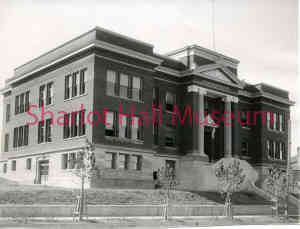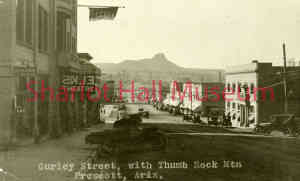By Mick Woodcock
The United States was somewhat slow on the uptake in dealing with the flu pandemic of 1918 as a national health hazard. Part of this may have been because World War I was in full swing.
The Weekly Journal-Miner, November 2, 1918, featured a front-page article with the headline “Spanish ‘Flu’ Claims Many New Victims.” This Associated Press (AP) article from Washington, D.C. dated September 30 stated there were more than 20,000 new cases in army camps from the previous forty-eight hours. There is no mention in the local headlines of the virus in Yavapai County.
 One week later, however, Arizona flu news was on the front page of the Prescott newspaper with the headline “Disease Spreads to Southern Counties.” The article stated, “Globe, Oct. 7 – Acting on instructions from government officials in Washington the Gila county health board issued orders this evening closing the schools, poolhalls, theatres and places of amusement until further notice.” It noted 60 cases in the towns of Globe and Miami and 125 cases in Bisbee, all mining towns with people living and working in close proximity.
One week later, however, Arizona flu news was on the front page of the Prescott newspaper with the headline “Disease Spreads to Southern Counties.” The article stated, “Globe, Oct. 7 – Acting on instructions from government officials in Washington the Gila county health board issued orders this evening closing the schools, poolhalls, theatres and places of amusement until further notice.” It noted 60 cases in the towns of Globe and Miami and 125 cases in Bisbee, all mining towns with people living and working in close proximity.
An adjacent article originating from Washington, D. C. announced that the “Red Cross Will Aid In Combat Of Epidemic” “Corps of Nurses and Hugh Accumulations of Supplies will be Placed at Disposal of Health Boards.” It also reported, “Influenza cases in all camps since the disease became an epidemic total 67,000, with 4,901 deaths.” This total did not account for what was happening in the civilian population.
An article on page five had the following headline, “Quarantine City As Influenza List Grows” “Epidemic Takes New Toll Among Soldiers and Civilians, And All Public Gatherings Are Forbidden.” City health officer Dr. J.W. Flinn, acting on directions issued by the Surgeon General in Washington, D.C., stated, “until further orders no public gathering of any sort will be allowed in this city…” This closed city schools, churches, lodges, and the one movie theater.
The article went on to describe the spread of the virus locally. It mentioned several new cases among the civilian population, but the majority were at the Fort Whipple U. S. Army Hospital , where two men passed away the previous Sunday. Without a full scientific understanding of influenza’s effect on the lungs, Hospital Commander Colonel Holmberg stated that these men died of tuberculosis, not the flu.
 Further along, the article stated there were more than 400 cases in Winslow and nine people had already died from the disease. At that time, Winslow had a major railway yard on the Atchison, Topeka and Santa Fe Railway, a key artery for travel across the country, providing ample opportunity for the disease to be transferred from place to place. Winslow officials attributed the infection to the Gentry Circus which had been there a couple of weeks earlier.
Further along, the article stated there were more than 400 cases in Winslow and nine people had already died from the disease. At that time, Winslow had a major railway yard on the Atchison, Topeka and Santa Fe Railway, a key artery for travel across the country, providing ample opportunity for the disease to be transferred from place to place. Winslow officials attributed the infection to the Gentry Circus which had been there a couple of weeks earlier.
On page six of the same edition, news of the deaths of three men was reported. One of the Winslow casualties was Frank Draper, a locomotive engineer and former Prescott resident. The newspaper indicated, “Mr. Draper was born in Prescott. He was the son of Mr. and Mrs. E. J. Draper, both recently deceased, the family being prominently known in this county as pioneers.”
While this was only the beginning of closures and casualties from the 1918 influenza pandemic, news gradually improved. A March 12, 1919 Weekly Journal-Miner headline stated, “Cornville Has Banished the Influenza” because its school had reopened. March 26 readers learned several prominent Prescott citizens were fully recovered. The pandemic declining, the April 23 edition printed this Arizona Board of Health statement: “It has been a source of gratification . . . to witness the splendid co-operative spirit . . . of both sexes who have spared neither time nor money in assisting in combating the epidemic.”
“Days Past” is a collaborative project of the Sharlot Hall Museum and the Prescott Corral of Westerners International (www.prescottcorral.org). This and other Days Past articles are also available at https://www.sharlot.org/articles/days-past-articles.l. The public is encouraged to submit proposed articles and inquiries to dayspast@sharlothallmuseum.org. Please contact SHM Research Center reference desk at 928-445-3122 Ext. 2, or via email at archivesrequest@sharlothallmuseum.org for information or assistance with photo requests.


